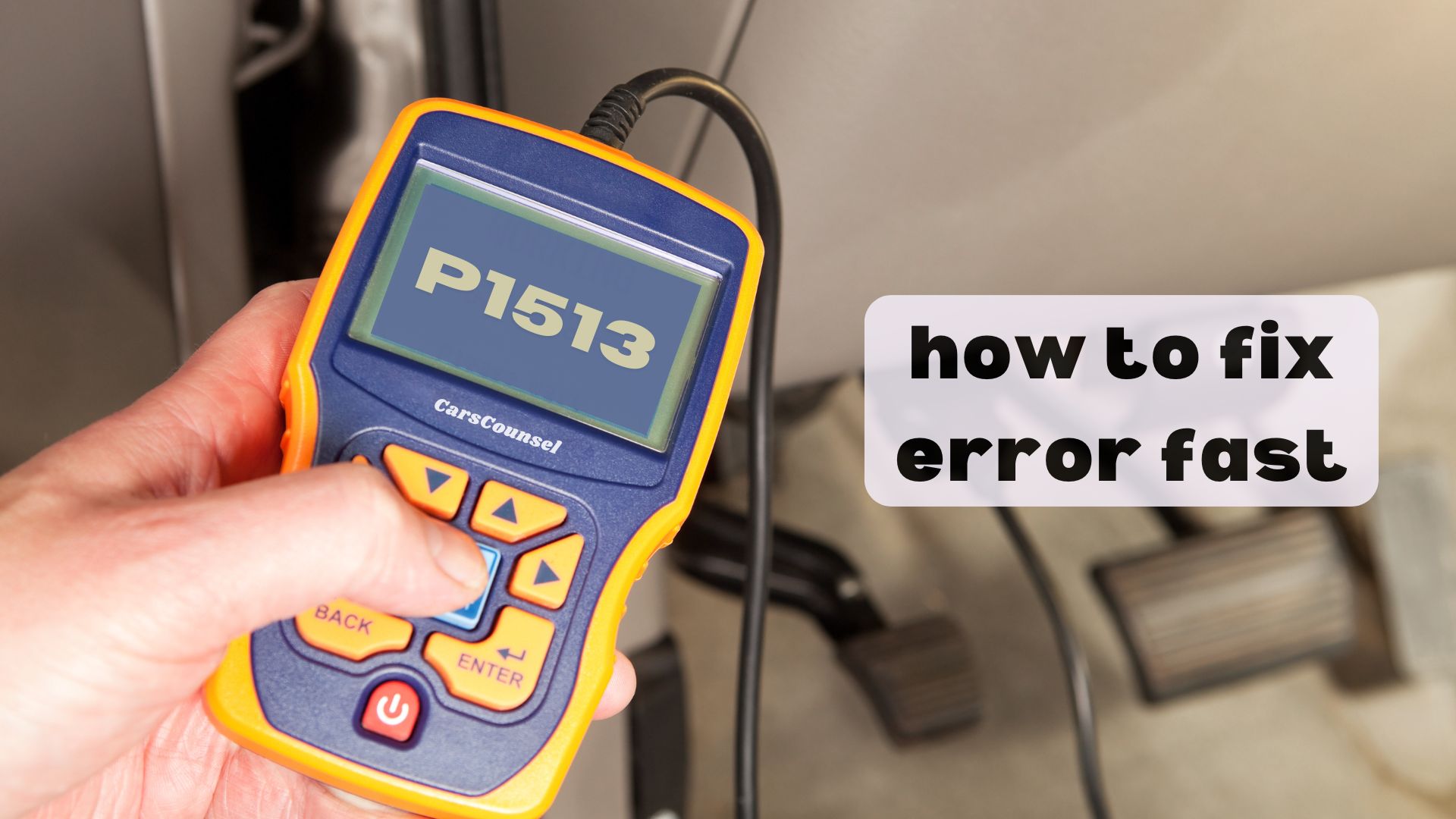Just like a well-oiled machine can quickly turn into a rusty relic, your engine’s performance can take a drastic turn for the worse when its Intake Manifold Runner Control (IMRC) system malfunctions.
You’re probably aware that the check engine light has illuminated, but do you know what’s causing it to glow? The P1513 code is pointing to a stuck closed IMRC on Bank 2, restricting airflow and affecting your engine’s overall performance.
But what’s behind this issue, and how can you get your engine running smoothly again? The solution lies in understanding the IMRC system and identifying the root cause of the problem – and that’s exactly where we’re headed next.

Quick Navigation
Key Takeaways
- The P1513 code indicates an issue with the Intake Manifold Runner Control (IMRC) system, specifically that it’s stuck closed on Bank 2.
- A faulty IMRC system can negatively impact vehicle performance, leading to decreased engine power, reduced fuel efficiency, and drivability issues.
- Common causes of the P1513 code include a faulty valve actuator, carbon accumulation, electrical issues, faulty sensors, and clogged intake manifold runners.
- Symptoms of the P1513 code include decreased engine performance, rough idling or stalling, and the check engine light illuminating on the dashboard.
- To diagnose the issue, analyze engine performance data, inspect the IMRC system, check electrical connections, perform a circuit analysis, and use a vacuum gauge to detect vacuum leaks.
Code P1513 Description
When your vehicle’s onboard computer triggers the P1513 code, it’s indicating a specific issue with the Intake Manifold Runner Control (IMRC) system.
This system is designed to optimize airflow into the engine, improving manifold performance and engine optimization. However, when the runner control is stuck closed, it restricts airflow, leading to a decrease in engine performance, reduced fuel efficiency, and potentially causing drivability issues.
This code can trigger the check engine light to illuminate on the dashboard.
The IMRC system is responsible for improving engine performance and efficiency.
A faulty IMRC system can negatively impact your vehicle’s overall performance, making it essential to address the issue promptly.
IMRC System Overview
The Intake Manifold Runner Control (IMRC) system is a vital component of your vehicle’s engine, responsible for maximizing airflow into the engine to improve performance and efficiency.
As you drive, the IMRC system adjusts the length of the intake manifold runners to match the engine’s operating conditions. This airflow refinement leads to better engine performance, increased power, and improved fuel efficiency.
The IMRC system is designed to provide the ideal airflow for various driving scenarios, ensuring your engine performs at its best. By dynamically adjusting airflow, the IMRC system helps your engine breathe easier, resulting in a smoother and more responsive driving experience.
Common Causes of P1513
Faulty components and malfunctioning systems can trigger the P1513 code, and it’s essential to identify the root cause to implement the correct repair.
You’ll need to inspect the intake manifold runner control system to determine the culprit.
Here are some common causes to look out for:
- Faulty valve actuator: A faulty intake manifold runner control valve can stick closed, restricting airflow and triggering the P1513 code.
- Carbon accumulation: Carbon buildup in the intake manifold runners can prevent the control from opening, leading to a stuck-closed condition.
- Electrical issues: A broken wire or faulty connector can disrupt the electrical signal, causing the runner control to malfunction.
Symptoms of P1513 Code
As you experience issues with your vehicle, you may notice a decrease in engine performance, which can be a symptom of the P1513 code.
This decrease in performance can manifest as reduced engine power, making it harder to accelerate or climb steep hills. You may also notice a decrease in fuel efficiency, leading to more frequent fill-ups.
Additionally, you might experience rough idling or stalling, as well as engine misfires. The check engine light on your dashboard will likely illuminate, indicating that there’s an issue with your vehicle’s engine.
Diagnosing the Issue
To diagnose the P1513 code, you’ll need to get to the root of the issue, and that starts with using a scan tool to confirm the code and inspect the intake manifold runner control system.
This will give you a clear understanding of the engine’s performance and help you identify any potential problems.
Next, you’ll want to:
- Analyze engine performance data using the scan tool to determine if the engine is running rich or lean, and if there are any misfire trouble codes present.
- Inspect the intake manifold runner control system for any signs of physical damage or carbon buildup.
- Check the electrical connections to verify they’re clean and free of corrosion, and to guarantee they’re secure and free of corrosion.
Repairing the IMRC System
With the diagnosis complete, you’re now ready to tackle the repair of the Intake Manifold Runner Control (IMRC) system.
Start by cleaning the intake manifold runners using effective runner cleaning techniques to remove any carbon buildup that may be causing the control to stick. This is a vital step in IMRC troubleshooting, as it can resolve the issue without requiring further repairs.
Next, test the intake manifold runner control valve and replace it if faulty. Make sure to follow proper repair procedures to guarantee the IMRC system is functioning correctly.
Electrical System Inspection
Most electrical issues related to the Intake Manifold Runner Control (IMRC) system can be traced back to faulty wiring or connectors.
As you inspect the electrical system, you’ll want to focus on identifying wiring faults that could be causing the IMRC system to malfunction.
Perform a circuit analysis to pinpoint the source of the issue. Check for:
- Damaged or corroded wiring: Look for signs of wear, corrosion, or physical damage that could be disrupting the electrical signal.
- Loose or corroded connectors: Verify all connectors are securely attached and free from corrosion.
- Faulty electrical components: Inspect the IMRC system’s electrical components, such as sensors and actuators, for signs of failure.
Vacuum Leak Detection
During routine diagnosis of the P1513 code, vacuum leak detection becomes a crucial step in identifying potential issues within the intake manifold system.
You’ll need to inspect the intake manifold runners and surrounding components for any signs of vacuum leaks. To do this, you can use leak testing methods such as a smoke test or a pressure test.
A vacuum gauge is also indispensable in detecting vacuum leaks, as it can measure the pressure drop in the intake manifold system. By attaching the vacuum gauge to the intake manifold, you can observe the pressure reading and identify if there’s a leak.
If a leak is detected, you’ll need to locate and repair it to guarantee proper airflow and engine performance.
Cost to Fix P1513 Code
Frequently, the cost to fix a P1513 code can be a significant concern for vehicle owners, as it depends on the underlying cause of the issue and the labor rates in their area.
You’ll want to get a repair estimate from a trusted mechanic or dealership to get a better idea of the costs involved.
- Replacing a faulty intake manifold runner control valve: $200-$500, including parts and labor.
- Cleaning the intake manifold runners: $100-$300, depending on the complexity of the process.
- Repairing electrical wiring or connections: $50-$200, depending on the extent of the damage.
It’s essential to check your vehicle’s warranty coverage to see if it covers any of these repairs.
Getting an accurate estimate will help you plan and budget for the necessary repairs.
Importance and Difficulty Level
When you’re faced with a P1513 code, it’s not just about getting a repair estimate – you also want to know how urgent the issue is and how complex the fix will be.
The repair importance level for this code is 3, indicating that it’s essential to address the issue promptly to prevent further engine damage and performance issues.
As for the repair difficulty level, it’s rated a 2, which means it’s moderately complex. While a DIY-savvy individual may be able to tackle the repair, it’s recommended to consult a professional mechanic to guarantee the job is done correctly and efficiently.
The repair complexity is relatively high due to the need to diagnose and repair the IMRC system, which requires specialized tools and knowledge.
More OBD-II Codes
Frequently Asked Questions
Can a Stuck IMRC Cause Engine Damage if Left Unrepaired?
If you leave a stuck IMRC unrepaired, it can cause performance loss and potentially lead to engine overheating, which can result in costly damage to your engine’s components, such as cylinder heads, engine blocks, or head gaskets, over time.
Will a P1513 Code Trigger a Failed Emissions Test?
When you’re driving a 2012 Honda Civic with a stuck IMRC, you might pass a visual emissions inspection, but the “check engine” light will trigger a failed test under OBDII protocol, as the onboard computer monitors emissions standards, detecting excessive emissions due to restricted airflow.
Can I Drive Safely With a P1513 Code Illuminated?
You can drive with a P1513 code, but be aware of reduced engine power and efficiency, affecting safe acceleration; however, it’s not an immediate safety concern, allowing you to drive cautiously to a repair shop for a fix.
Is It Possible to Clean the IMRC System Instead of Replacing It?
“An ounce of prevention is worth a pound of cure.” You can clean the IMRC system, but it’s vital to address the underlying issue, like carbon buildup, to prevent recurrence. The IMRC design allows for airflow optimization, so a thorough cleaning might resolve the stuck closed issue, but replacement may still be necessary if the problem is pivotal.
Does a P1513 Code Always Indicate a Faulty IMRC Valve?
You shouldn’t assume a P1513 code always means a faulty IMRC valve; it could be faulty wiring, electrical surges, or other issues causing the stuck closed condition, so it’s essential to diagnose the root cause before replacing the valve.
Conclusion
You’ve got a P1513 code, and now you’re left wondering what’s next. Can you really afford to ignore the decreased engine performance and reduced fuel efficiency? As you’ve seen, the IMRC system is a complex beast, and fixing the issue requires a thorough diagnosis and repair. Don’t let a stuck closed intake manifold runner control on Bank 2 hold you back – take control and get your engine running smoothly again.

